The Global Food Security Challenge: An Economic Analysis
VerifiedAdded on 2021/06/15
|22
|6712
|53
Report
AI Summary
This report provides a comprehensive overview of the global food security challenge. It begins by defining food security and highlighting the staggering number of people affected by food insecurity and malnutrition. The report then delves into the core of the problem, emphasizing the critical need to feed a growing global population, with a focus on the key drivers of food insecurity, including population growth, changing dietary preferences, climate change, and water scarcity. It also discusses the impact of geopolitical differences and natural calamities. The report examines the current situation, including ongoing efforts by governments and health organizations to address the issue. It emphasizes the importance of sustainable agriculture and the role of market sectors and customer behavior in food security. The report concludes by offering recommendations for improving food security and ensuring a sustainable food supply for future generations, stressing the role of agriculture in providing income and food security for vulnerable populations.
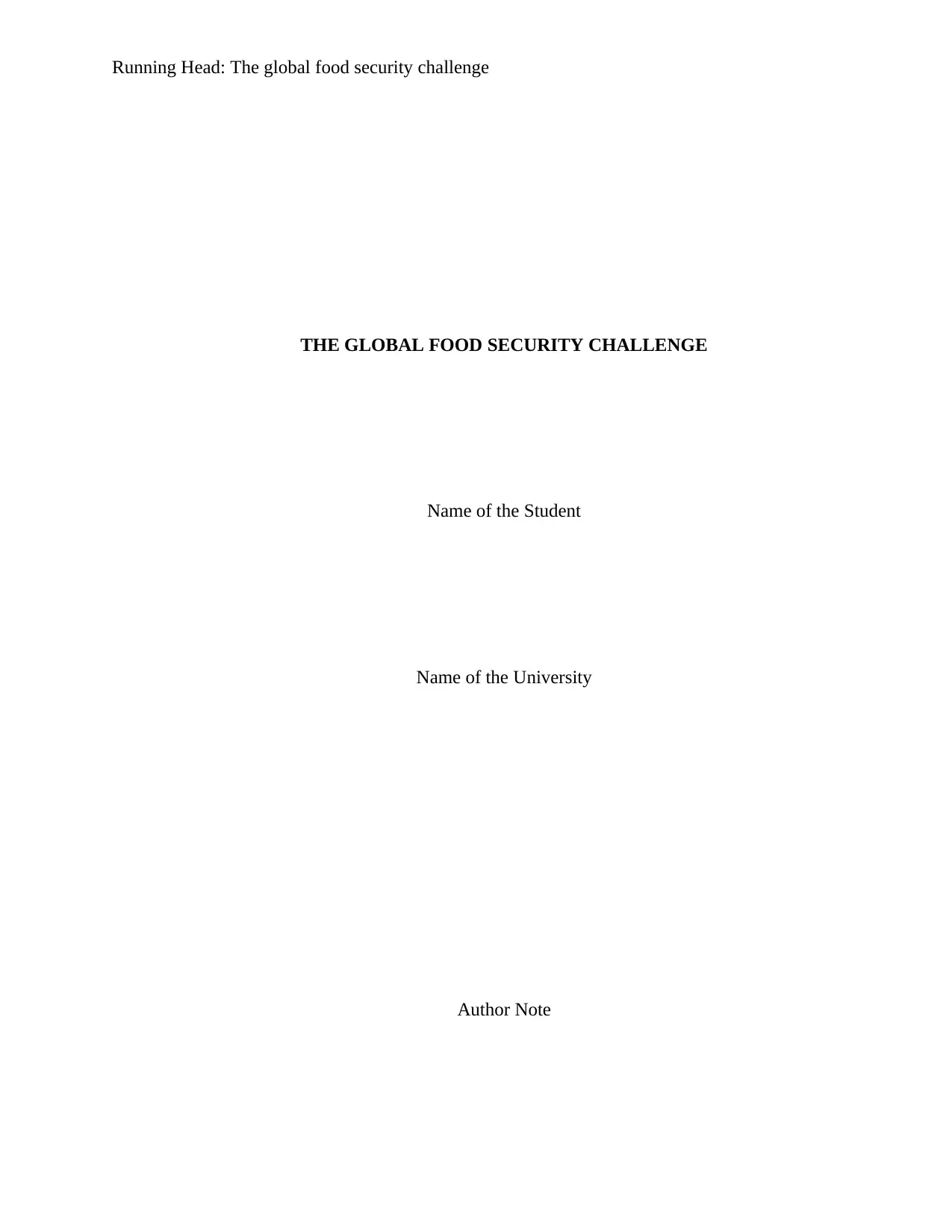
Running Head: The global food security challenge
THE GLOBAL FOOD SECURITY CHALLENGE
Name of the Student
Name of the University
Author Note
THE GLOBAL FOOD SECURITY CHALLENGE
Name of the Student
Name of the University
Author Note
Paraphrase This Document
Need a fresh take? Get an instant paraphrase of this document with our AI Paraphraser

1
THE GLOBAL FOOD SECURITY CHALLENGE
Table of Contents
Introduction..........................................................................................................................2
The problem.........................................................................................................................3
Current situations.................................................................................................................6
Recommendations and conclusion....................................................................................11
References..........................................................................................................................16
Appendix............................................................................................................................21
THE GLOBAL FOOD SECURITY CHALLENGE
Table of Contents
Introduction..........................................................................................................................2
The problem.........................................................................................................................3
Current situations.................................................................................................................6
Recommendations and conclusion....................................................................................11
References..........................................................................................................................16
Appendix............................................................................................................................21
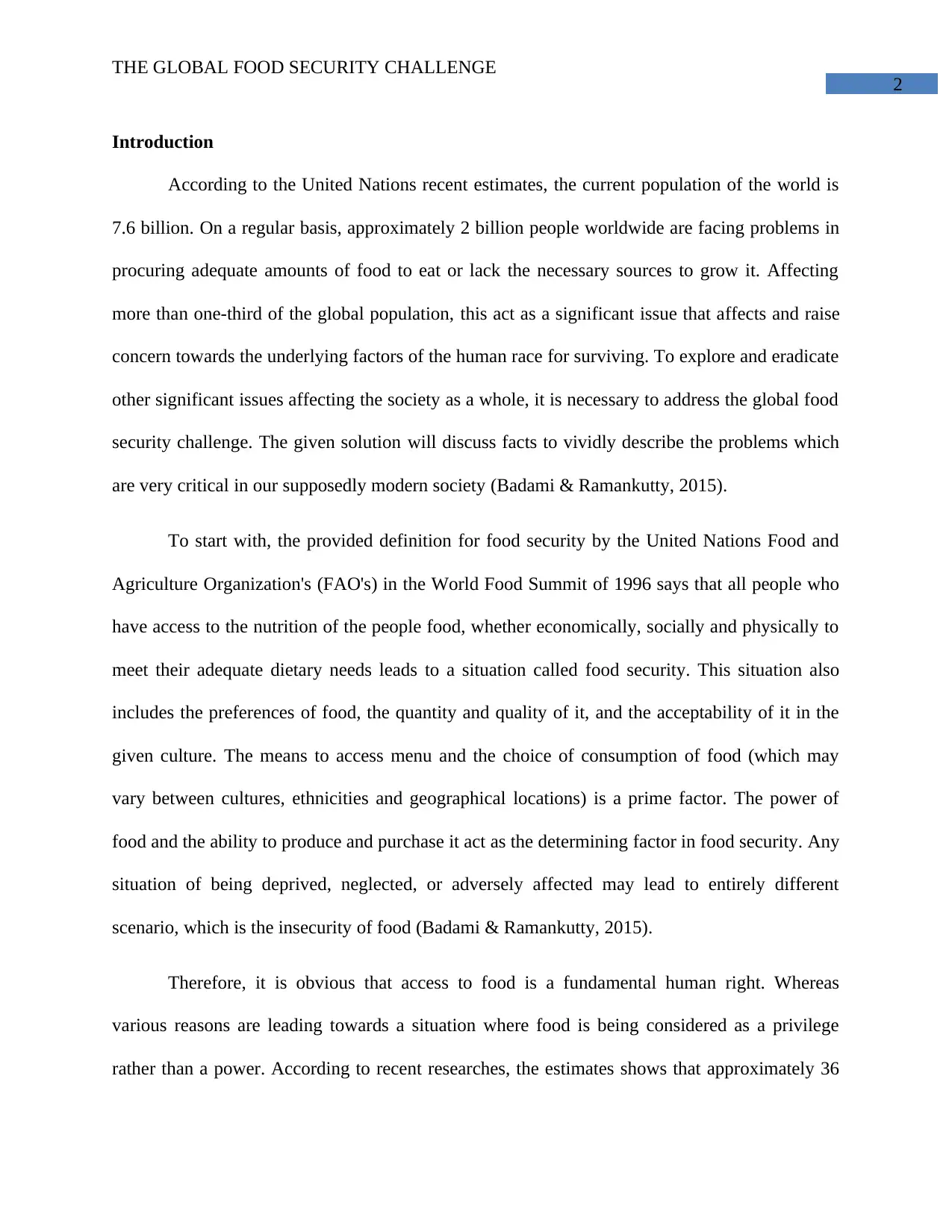
2
THE GLOBAL FOOD SECURITY CHALLENGE
Introduction
According to the United Nations recent estimates, the current population of the world is
7.6 billion. On a regular basis, approximately 2 billion people worldwide are facing problems in
procuring adequate amounts of food to eat or lack the necessary sources to grow it. Affecting
more than one-third of the global population, this act as a significant issue that affects and raise
concern towards the underlying factors of the human race for surviving. To explore and eradicate
other significant issues affecting the society as a whole, it is necessary to address the global food
security challenge. The given solution will discuss facts to vividly describe the problems which
are very critical in our supposedly modern society (Badami & Ramankutty, 2015).
To start with, the provided definition for food security by the United Nations Food and
Agriculture Organization's (FAO's) in the World Food Summit of 1996 says that all people who
have access to the nutrition of the people food, whether economically, socially and physically to
meet their adequate dietary needs leads to a situation called food security. This situation also
includes the preferences of food, the quantity and quality of it, and the acceptability of it in the
given culture. The means to access menu and the choice of consumption of food (which may
vary between cultures, ethnicities and geographical locations) is a prime factor. The power of
food and the ability to produce and purchase it act as the determining factor in food security. Any
situation of being deprived, neglected, or adversely affected may lead to entirely different
scenario, which is the insecurity of food (Badami & Ramankutty, 2015).
Therefore, it is obvious that access to food is a fundamental human right. Whereas
various reasons are leading towards a situation where food is being considered as a privilege
rather than a power. According to recent researches, the estimates shows that approximately 36
THE GLOBAL FOOD SECURITY CHALLENGE
Introduction
According to the United Nations recent estimates, the current population of the world is
7.6 billion. On a regular basis, approximately 2 billion people worldwide are facing problems in
procuring adequate amounts of food to eat or lack the necessary sources to grow it. Affecting
more than one-third of the global population, this act as a significant issue that affects and raise
concern towards the underlying factors of the human race for surviving. To explore and eradicate
other significant issues affecting the society as a whole, it is necessary to address the global food
security challenge. The given solution will discuss facts to vividly describe the problems which
are very critical in our supposedly modern society (Badami & Ramankutty, 2015).
To start with, the provided definition for food security by the United Nations Food and
Agriculture Organization's (FAO's) in the World Food Summit of 1996 says that all people who
have access to the nutrition of the people food, whether economically, socially and physically to
meet their adequate dietary needs leads to a situation called food security. This situation also
includes the preferences of food, the quantity and quality of it, and the acceptability of it in the
given culture. The means to access menu and the choice of consumption of food (which may
vary between cultures, ethnicities and geographical locations) is a prime factor. The power of
food and the ability to produce and purchase it act as the determining factor in food security. Any
situation of being deprived, neglected, or adversely affected may lead to entirely different
scenario, which is the insecurity of food (Badami & Ramankutty, 2015).
Therefore, it is obvious that access to food is a fundamental human right. Whereas
various reasons are leading towards a situation where food is being considered as a privilege
rather than a power. According to recent researches, the estimates shows that approximately 36
⊘ This is a preview!⊘
Do you want full access?
Subscribe today to unlock all pages.

Trusted by 1+ million students worldwide
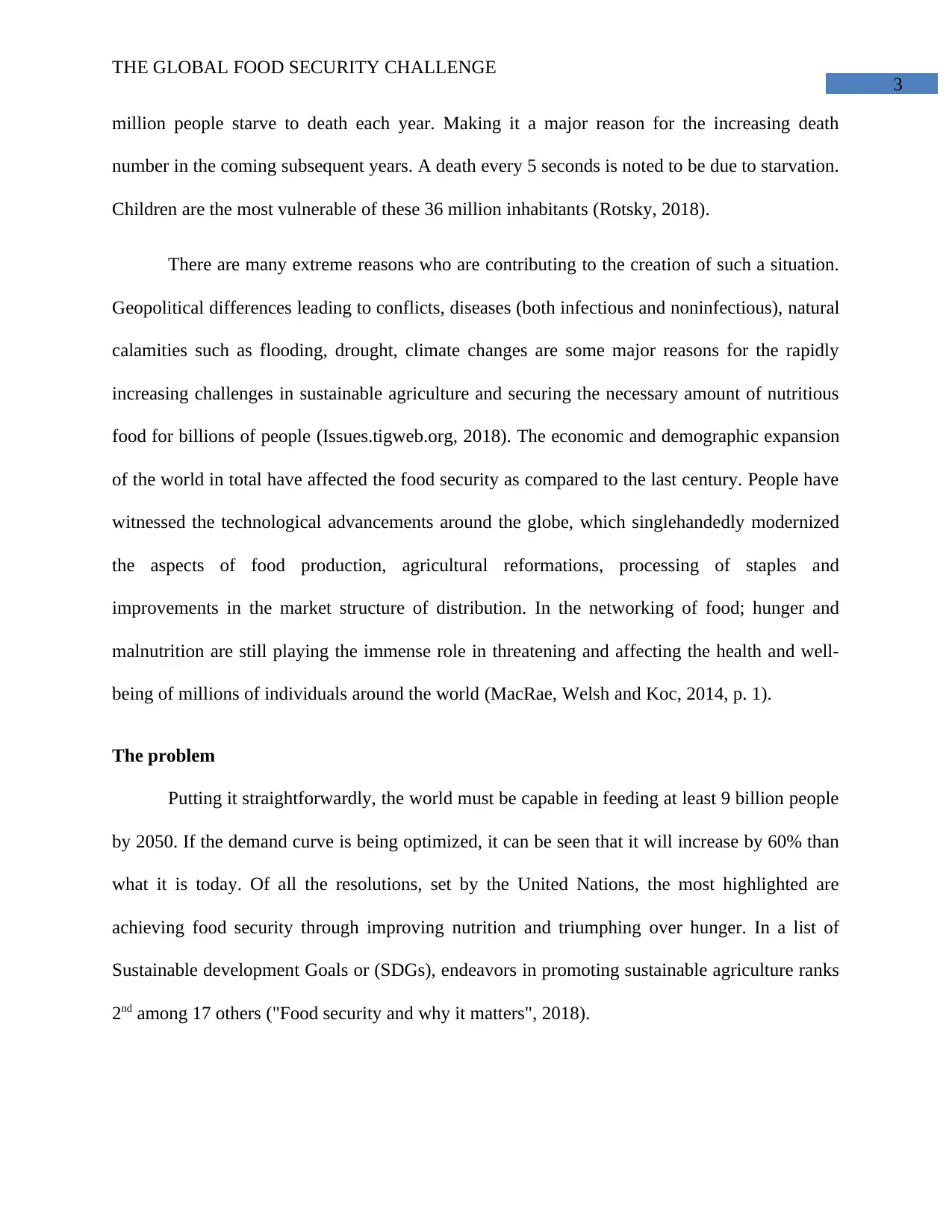
3
THE GLOBAL FOOD SECURITY CHALLENGE
million people starve to death each year. Making it a major reason for the increasing death
number in the coming subsequent years. A death every 5 seconds is noted to be due to starvation.
Children are the most vulnerable of these 36 million inhabitants (Rotsky, 2018).
There are many extreme reasons who are contributing to the creation of such a situation.
Geopolitical differences leading to conflicts, diseases (both infectious and noninfectious), natural
calamities such as flooding, drought, climate changes are some major reasons for the rapidly
increasing challenges in sustainable agriculture and securing the necessary amount of nutritious
food for billions of people (Issues.tigweb.org, 2018). The economic and demographic expansion
of the world in total have affected the food security as compared to the last century. People have
witnessed the technological advancements around the globe, which singlehandedly modernized
the aspects of food production, agricultural reformations, processing of staples and
improvements in the market structure of distribution. In the networking of food; hunger and
malnutrition are still playing the immense role in threatening and affecting the health and well-
being of millions of individuals around the world (MacRae, Welsh and Koc, 2014, p. 1).
The problem
Putting it straightforwardly, the world must be capable in feeding at least 9 billion people
by 2050. If the demand curve is being optimized, it can be seen that it will increase by 60% than
what it is today. Of all the resolutions, set by the United Nations, the most highlighted are
achieving food security through improving nutrition and triumphing over hunger. In a list of
Sustainable development Goals or (SDGs), endeavors in promoting sustainable agriculture ranks
2nd among 17 others ("Food security and why it matters", 2018).
THE GLOBAL FOOD SECURITY CHALLENGE
million people starve to death each year. Making it a major reason for the increasing death
number in the coming subsequent years. A death every 5 seconds is noted to be due to starvation.
Children are the most vulnerable of these 36 million inhabitants (Rotsky, 2018).
There are many extreme reasons who are contributing to the creation of such a situation.
Geopolitical differences leading to conflicts, diseases (both infectious and noninfectious), natural
calamities such as flooding, drought, climate changes are some major reasons for the rapidly
increasing challenges in sustainable agriculture and securing the necessary amount of nutritious
food for billions of people (Issues.tigweb.org, 2018). The economic and demographic expansion
of the world in total have affected the food security as compared to the last century. People have
witnessed the technological advancements around the globe, which singlehandedly modernized
the aspects of food production, agricultural reformations, processing of staples and
improvements in the market structure of distribution. In the networking of food; hunger and
malnutrition are still playing the immense role in threatening and affecting the health and well-
being of millions of individuals around the world (MacRae, Welsh and Koc, 2014, p. 1).
The problem
Putting it straightforwardly, the world must be capable in feeding at least 9 billion people
by 2050. If the demand curve is being optimized, it can be seen that it will increase by 60% than
what it is today. Of all the resolutions, set by the United Nations, the most highlighted are
achieving food security through improving nutrition and triumphing over hunger. In a list of
Sustainable development Goals or (SDGs), endeavors in promoting sustainable agriculture ranks
2nd among 17 others ("Food security and why it matters", 2018).
Paraphrase This Document
Need a fresh take? Get an instant paraphrase of this document with our AI Paraphraser
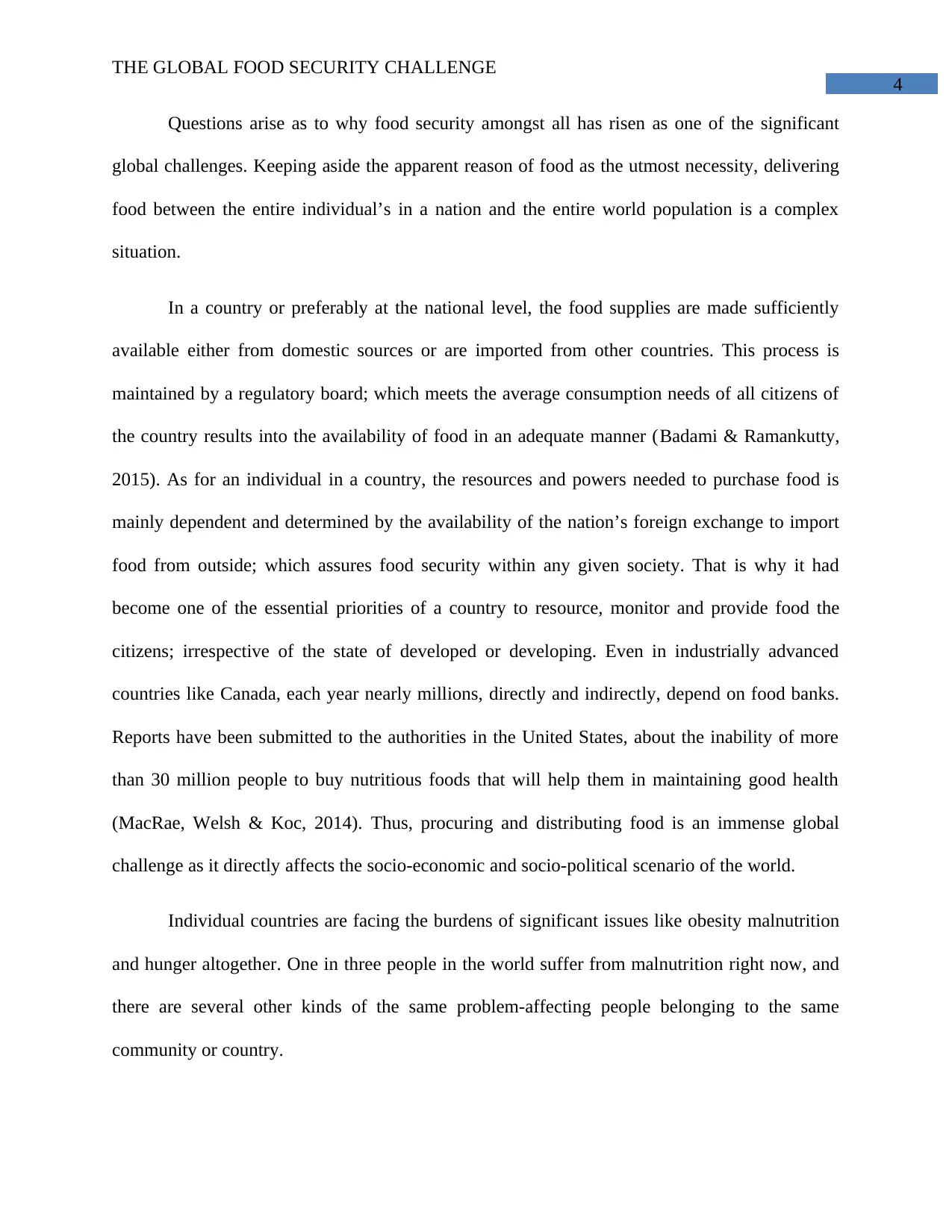
4
THE GLOBAL FOOD SECURITY CHALLENGE
Questions arise as to why food security amongst all has risen as one of the significant
global challenges. Keeping aside the apparent reason of food as the utmost necessity, delivering
food between the entire individual’s in a nation and the entire world population is a complex
situation.
In a country or preferably at the national level, the food supplies are made sufficiently
available either from domestic sources or are imported from other countries. This process is
maintained by a regulatory board; which meets the average consumption needs of all citizens of
the country results into the availability of food in an adequate manner (Badami & Ramankutty,
2015). As for an individual in a country, the resources and powers needed to purchase food is
mainly dependent and determined by the availability of the nation’s foreign exchange to import
food from outside; which assures food security within any given society. That is why it had
become one of the essential priorities of a country to resource, monitor and provide food the
citizens; irrespective of the state of developed or developing. Even in industrially advanced
countries like Canada, each year nearly millions, directly and indirectly, depend on food banks.
Reports have been submitted to the authorities in the United States, about the inability of more
than 30 million people to buy nutritious foods that will help them in maintaining good health
(MacRae, Welsh & Koc, 2014). Thus, procuring and distributing food is an immense global
challenge as it directly affects the socio-economic and socio-political scenario of the world.
Individual countries are facing the burdens of significant issues like obesity malnutrition
and hunger altogether. One in three people in the world suffer from malnutrition right now, and
there are several other kinds of the same problem-affecting people belonging to the same
community or country.
THE GLOBAL FOOD SECURITY CHALLENGE
Questions arise as to why food security amongst all has risen as one of the significant
global challenges. Keeping aside the apparent reason of food as the utmost necessity, delivering
food between the entire individual’s in a nation and the entire world population is a complex
situation.
In a country or preferably at the national level, the food supplies are made sufficiently
available either from domestic sources or are imported from other countries. This process is
maintained by a regulatory board; which meets the average consumption needs of all citizens of
the country results into the availability of food in an adequate manner (Badami & Ramankutty,
2015). As for an individual in a country, the resources and powers needed to purchase food is
mainly dependent and determined by the availability of the nation’s foreign exchange to import
food from outside; which assures food security within any given society. That is why it had
become one of the essential priorities of a country to resource, monitor and provide food the
citizens; irrespective of the state of developed or developing. Even in industrially advanced
countries like Canada, each year nearly millions, directly and indirectly, depend on food banks.
Reports have been submitted to the authorities in the United States, about the inability of more
than 30 million people to buy nutritious foods that will help them in maintaining good health
(MacRae, Welsh & Koc, 2014). Thus, procuring and distributing food is an immense global
challenge as it directly affects the socio-economic and socio-political scenario of the world.
Individual countries are facing the burdens of significant issues like obesity malnutrition
and hunger altogether. One in three people in the world suffer from malnutrition right now, and
there are several other kinds of the same problem-affecting people belonging to the same
community or country.
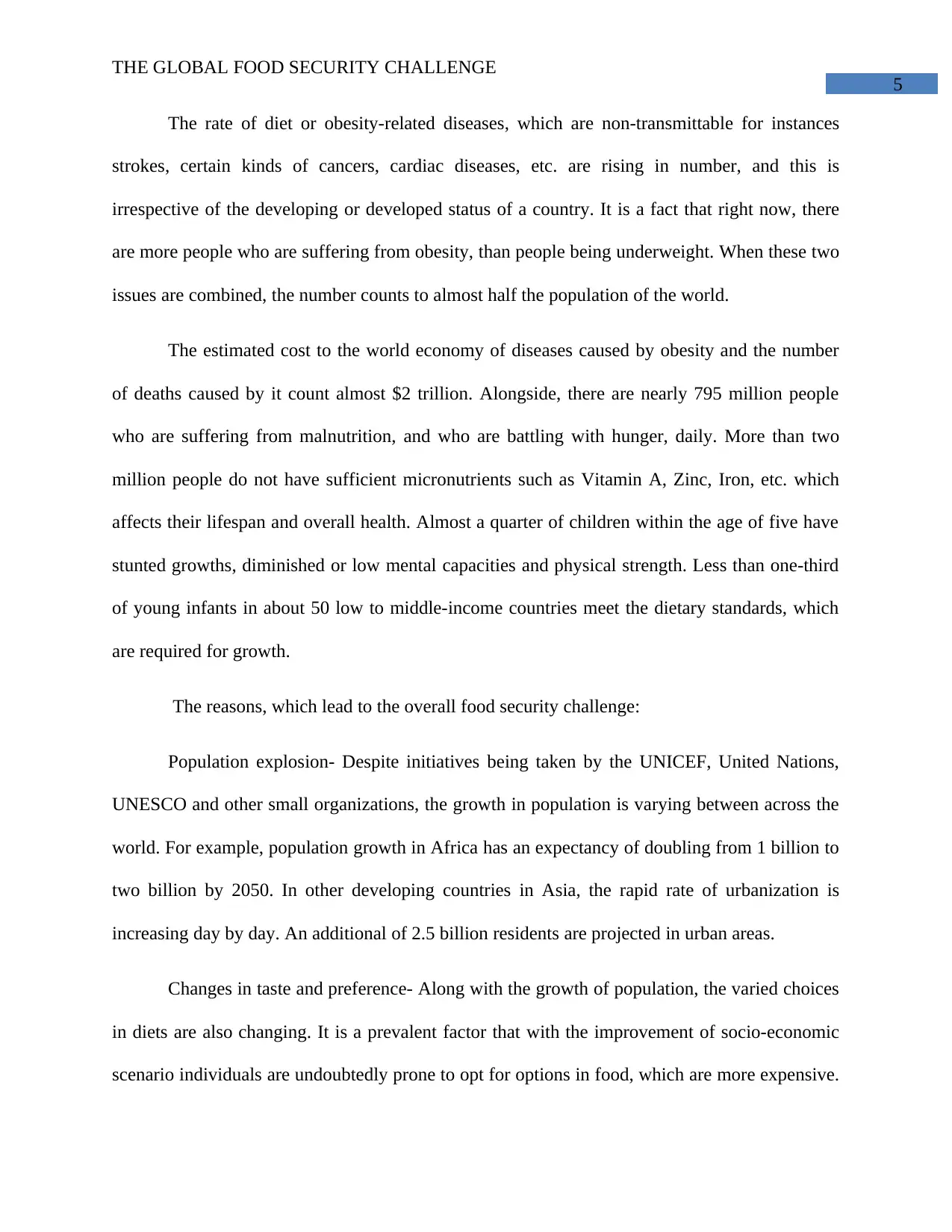
5
THE GLOBAL FOOD SECURITY CHALLENGE
The rate of diet or obesity-related diseases, which are non-transmittable for instances
strokes, certain kinds of cancers, cardiac diseases, etc. are rising in number, and this is
irrespective of the developing or developed status of a country. It is a fact that right now, there
are more people who are suffering from obesity, than people being underweight. When these two
issues are combined, the number counts to almost half the population of the world.
The estimated cost to the world economy of diseases caused by obesity and the number
of deaths caused by it count almost $2 trillion. Alongside, there are nearly 795 million people
who are suffering from malnutrition, and who are battling with hunger, daily. More than two
million people do not have sufficient micronutrients such as Vitamin A, Zinc, Iron, etc. which
affects their lifespan and overall health. Almost a quarter of children within the age of five have
stunted growths, diminished or low mental capacities and physical strength. Less than one-third
of young infants in about 50 low to middle-income countries meet the dietary standards, which
are required for growth.
The reasons, which lead to the overall food security challenge:
Population explosion- Despite initiatives being taken by the UNICEF, United Nations,
UNESCO and other small organizations, the growth in population is varying between across the
world. For example, population growth in Africa has an expectancy of doubling from 1 billion to
two billion by 2050. In other developing countries in Asia, the rapid rate of urbanization is
increasing day by day. An additional of 2.5 billion residents are projected in urban areas.
Changes in taste and preference- Along with the growth of population, the varied choices
in diets are also changing. It is a prevalent factor that with the improvement of socio-economic
scenario individuals are undoubtedly prone to opt for options in food, which are more expensive.
THE GLOBAL FOOD SECURITY CHALLENGE
The rate of diet or obesity-related diseases, which are non-transmittable for instances
strokes, certain kinds of cancers, cardiac diseases, etc. are rising in number, and this is
irrespective of the developing or developed status of a country. It is a fact that right now, there
are more people who are suffering from obesity, than people being underweight. When these two
issues are combined, the number counts to almost half the population of the world.
The estimated cost to the world economy of diseases caused by obesity and the number
of deaths caused by it count almost $2 trillion. Alongside, there are nearly 795 million people
who are suffering from malnutrition, and who are battling with hunger, daily. More than two
million people do not have sufficient micronutrients such as Vitamin A, Zinc, Iron, etc. which
affects their lifespan and overall health. Almost a quarter of children within the age of five have
stunted growths, diminished or low mental capacities and physical strength. Less than one-third
of young infants in about 50 low to middle-income countries meet the dietary standards, which
are required for growth.
The reasons, which lead to the overall food security challenge:
Population explosion- Despite initiatives being taken by the UNICEF, United Nations,
UNESCO and other small organizations, the growth in population is varying between across the
world. For example, population growth in Africa has an expectancy of doubling from 1 billion to
two billion by 2050. In other developing countries in Asia, the rapid rate of urbanization is
increasing day by day. An additional of 2.5 billion residents are projected in urban areas.
Changes in taste and preference- Along with the growth of population, the varied choices
in diets are also changing. It is a prevalent factor that with the improvement of socio-economic
scenario individuals are undoubtedly prone to opt for options in food, which are more expensive.
⊘ This is a preview!⊘
Do you want full access?
Subscribe today to unlock all pages.

Trusted by 1+ million students worldwide
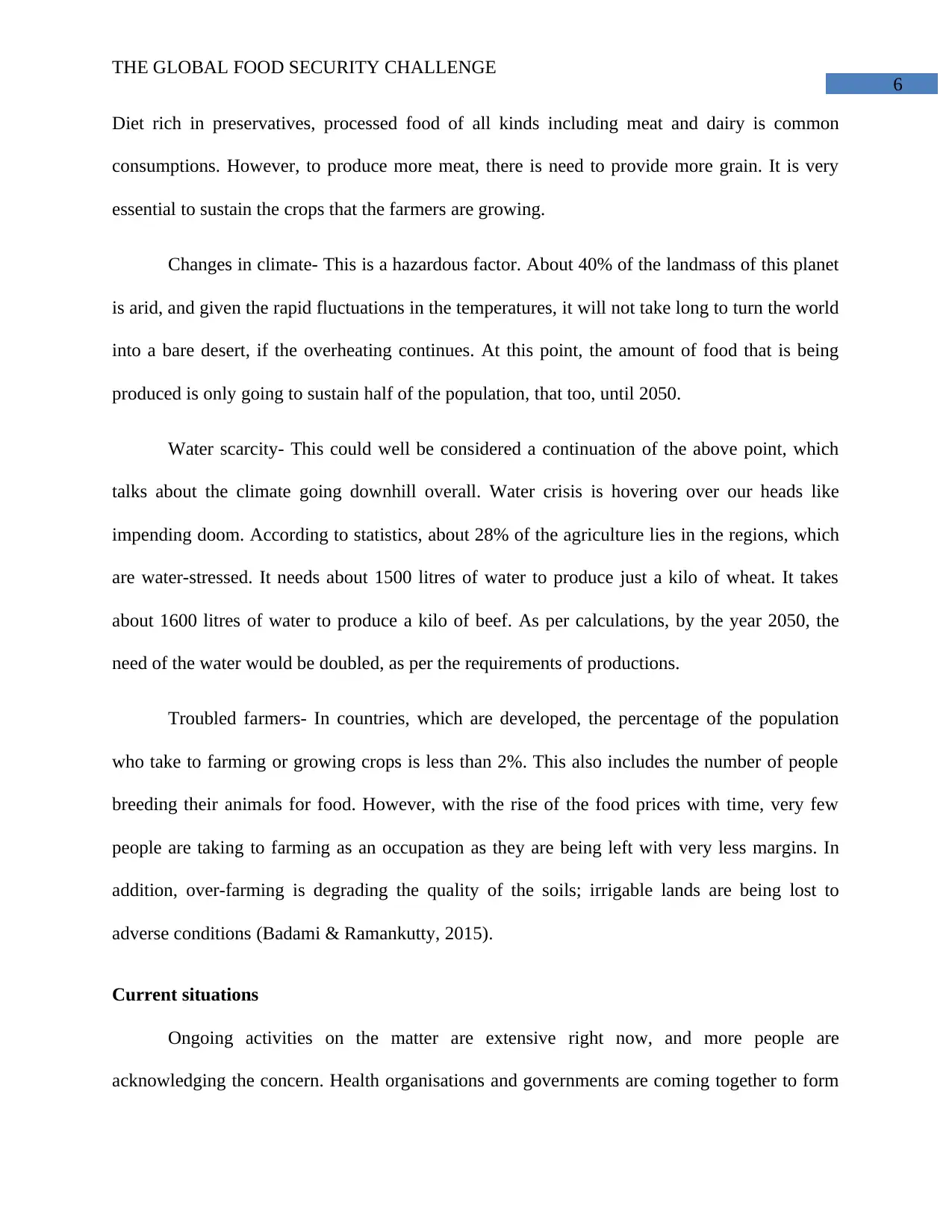
6
THE GLOBAL FOOD SECURITY CHALLENGE
Diet rich in preservatives, processed food of all kinds including meat and dairy is common
consumptions. However, to produce more meat, there is need to provide more grain. It is very
essential to sustain the crops that the farmers are growing.
Changes in climate- This is a hazardous factor. About 40% of the landmass of this planet
is arid, and given the rapid fluctuations in the temperatures, it will not take long to turn the world
into a bare desert, if the overheating continues. At this point, the amount of food that is being
produced is only going to sustain half of the population, that too, until 2050.
Water scarcity- This could well be considered a continuation of the above point, which
talks about the climate going downhill overall. Water crisis is hovering over our heads like
impending doom. According to statistics, about 28% of the agriculture lies in the regions, which
are water-stressed. It needs about 1500 litres of water to produce just a kilo of wheat. It takes
about 1600 litres of water to produce a kilo of beef. As per calculations, by the year 2050, the
need of the water would be doubled, as per the requirements of productions.
Troubled farmers- In countries, which are developed, the percentage of the population
who take to farming or growing crops is less than 2%. This also includes the number of people
breeding their animals for food. However, with the rise of the food prices with time, very few
people are taking to farming as an occupation as they are being left with very less margins. In
addition, over-farming is degrading the quality of the soils; irrigable lands are being lost to
adverse conditions (Badami & Ramankutty, 2015).
Current situations
Ongoing activities on the matter are extensive right now, and more people are
acknowledging the concern. Health organisations and governments are coming together to form
THE GLOBAL FOOD SECURITY CHALLENGE
Diet rich in preservatives, processed food of all kinds including meat and dairy is common
consumptions. However, to produce more meat, there is need to provide more grain. It is very
essential to sustain the crops that the farmers are growing.
Changes in climate- This is a hazardous factor. About 40% of the landmass of this planet
is arid, and given the rapid fluctuations in the temperatures, it will not take long to turn the world
into a bare desert, if the overheating continues. At this point, the amount of food that is being
produced is only going to sustain half of the population, that too, until 2050.
Water scarcity- This could well be considered a continuation of the above point, which
talks about the climate going downhill overall. Water crisis is hovering over our heads like
impending doom. According to statistics, about 28% of the agriculture lies in the regions, which
are water-stressed. It needs about 1500 litres of water to produce just a kilo of wheat. It takes
about 1600 litres of water to produce a kilo of beef. As per calculations, by the year 2050, the
need of the water would be doubled, as per the requirements of productions.
Troubled farmers- In countries, which are developed, the percentage of the population
who take to farming or growing crops is less than 2%. This also includes the number of people
breeding their animals for food. However, with the rise of the food prices with time, very few
people are taking to farming as an occupation as they are being left with very less margins. In
addition, over-farming is degrading the quality of the soils; irrigable lands are being lost to
adverse conditions (Badami & Ramankutty, 2015).
Current situations
Ongoing activities on the matter are extensive right now, and more people are
acknowledging the concern. Health organisations and governments are coming together to form
Paraphrase This Document
Need a fresh take? Get an instant paraphrase of this document with our AI Paraphraser
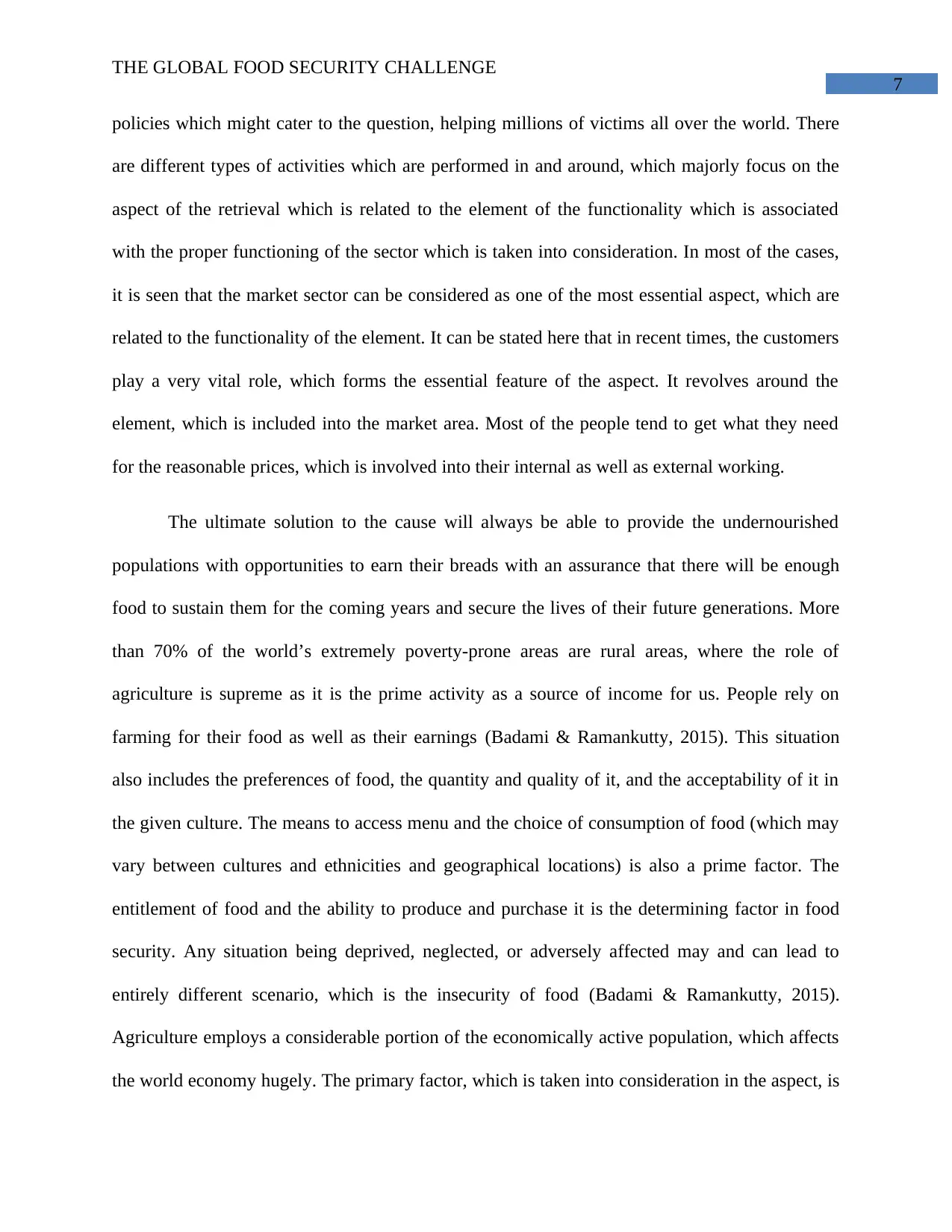
7
THE GLOBAL FOOD SECURITY CHALLENGE
policies which might cater to the question, helping millions of victims all over the world. There
are different types of activities which are performed in and around, which majorly focus on the
aspect of the retrieval which is related to the element of the functionality which is associated
with the proper functioning of the sector which is taken into consideration. In most of the cases,
it is seen that the market sector can be considered as one of the most essential aspect, which are
related to the functionality of the element. It can be stated here that in recent times, the customers
play a very vital role, which forms the essential feature of the aspect. It revolves around the
element, which is included into the market area. Most of the people tend to get what they need
for the reasonable prices, which is involved into their internal as well as external working.
The ultimate solution to the cause will always be able to provide the undernourished
populations with opportunities to earn their breads with an assurance that there will be enough
food to sustain them for the coming years and secure the lives of their future generations. More
than 70% of the world’s extremely poverty-prone areas are rural areas, where the role of
agriculture is supreme as it is the prime activity as a source of income for us. People rely on
farming for their food as well as their earnings (Badami & Ramankutty, 2015). This situation
also includes the preferences of food, the quantity and quality of it, and the acceptability of it in
the given culture. The means to access menu and the choice of consumption of food (which may
vary between cultures and ethnicities and geographical locations) is also a prime factor. The
entitlement of food and the ability to produce and purchase it is the determining factor in food
security. Any situation being deprived, neglected, or adversely affected may and can lead to
entirely different scenario, which is the insecurity of food (Badami & Ramankutty, 2015).
Agriculture employs a considerable portion of the economically active population, which affects
the world economy hugely. The primary factor, which is taken into consideration in the aspect, is
THE GLOBAL FOOD SECURITY CHALLENGE
policies which might cater to the question, helping millions of victims all over the world. There
are different types of activities which are performed in and around, which majorly focus on the
aspect of the retrieval which is related to the element of the functionality which is associated
with the proper functioning of the sector which is taken into consideration. In most of the cases,
it is seen that the market sector can be considered as one of the most essential aspect, which are
related to the functionality of the element. It can be stated here that in recent times, the customers
play a very vital role, which forms the essential feature of the aspect. It revolves around the
element, which is included into the market area. Most of the people tend to get what they need
for the reasonable prices, which is involved into their internal as well as external working.
The ultimate solution to the cause will always be able to provide the undernourished
populations with opportunities to earn their breads with an assurance that there will be enough
food to sustain them for the coming years and secure the lives of their future generations. More
than 70% of the world’s extremely poverty-prone areas are rural areas, where the role of
agriculture is supreme as it is the prime activity as a source of income for us. People rely on
farming for their food as well as their earnings (Badami & Ramankutty, 2015). This situation
also includes the preferences of food, the quantity and quality of it, and the acceptability of it in
the given culture. The means to access menu and the choice of consumption of food (which may
vary between cultures and ethnicities and geographical locations) is also a prime factor. The
entitlement of food and the ability to produce and purchase it is the determining factor in food
security. Any situation being deprived, neglected, or adversely affected may and can lead to
entirely different scenario, which is the insecurity of food (Badami & Ramankutty, 2015).
Agriculture employs a considerable portion of the economically active population, which affects
the world economy hugely. The primary factor, which is taken into consideration in the aspect, is
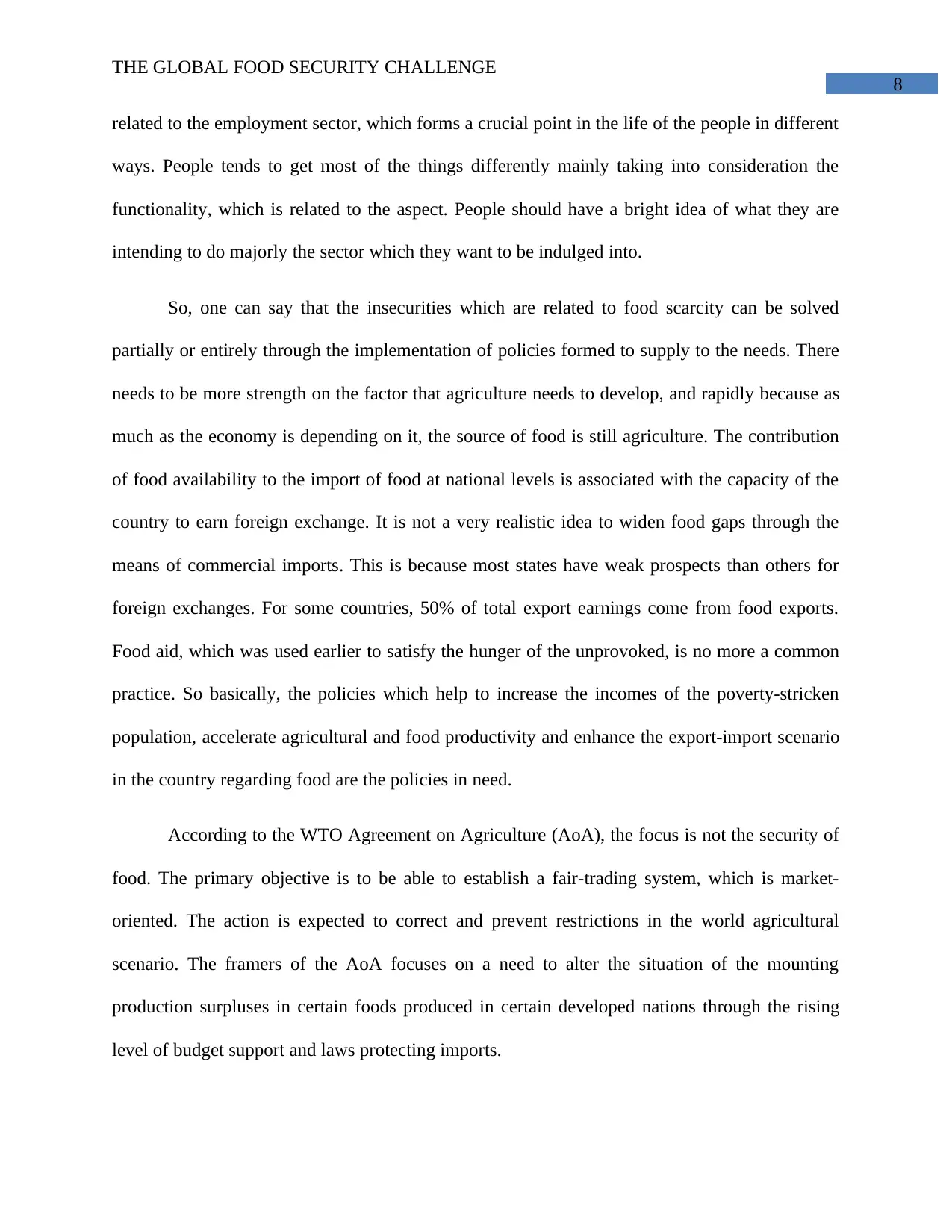
8
THE GLOBAL FOOD SECURITY CHALLENGE
related to the employment sector, which forms a crucial point in the life of the people in different
ways. People tends to get most of the things differently mainly taking into consideration the
functionality, which is related to the aspect. People should have a bright idea of what they are
intending to do majorly the sector which they want to be indulged into.
So, one can say that the insecurities which are related to food scarcity can be solved
partially or entirely through the implementation of policies formed to supply to the needs. There
needs to be more strength on the factor that agriculture needs to develop, and rapidly because as
much as the economy is depending on it, the source of food is still agriculture. The contribution
of food availability to the import of food at national levels is associated with the capacity of the
country to earn foreign exchange. It is not a very realistic idea to widen food gaps through the
means of commercial imports. This is because most states have weak prospects than others for
foreign exchanges. For some countries, 50% of total export earnings come from food exports.
Food aid, which was used earlier to satisfy the hunger of the unprovoked, is no more a common
practice. So basically, the policies which help to increase the incomes of the poverty-stricken
population, accelerate agricultural and food productivity and enhance the export-import scenario
in the country regarding food are the policies in need.
According to the WTO Agreement on Agriculture (AoA), the focus is not the security of
food. The primary objective is to be able to establish a fair-trading system, which is market-
oriented. The action is expected to correct and prevent restrictions in the world agricultural
scenario. The framers of the AoA focuses on a need to alter the situation of the mounting
production surpluses in certain foods produced in certain developed nations through the rising
level of budget support and laws protecting imports.
THE GLOBAL FOOD SECURITY CHALLENGE
related to the employment sector, which forms a crucial point in the life of the people in different
ways. People tends to get most of the things differently mainly taking into consideration the
functionality, which is related to the aspect. People should have a bright idea of what they are
intending to do majorly the sector which they want to be indulged into.
So, one can say that the insecurities which are related to food scarcity can be solved
partially or entirely through the implementation of policies formed to supply to the needs. There
needs to be more strength on the factor that agriculture needs to develop, and rapidly because as
much as the economy is depending on it, the source of food is still agriculture. The contribution
of food availability to the import of food at national levels is associated with the capacity of the
country to earn foreign exchange. It is not a very realistic idea to widen food gaps through the
means of commercial imports. This is because most states have weak prospects than others for
foreign exchanges. For some countries, 50% of total export earnings come from food exports.
Food aid, which was used earlier to satisfy the hunger of the unprovoked, is no more a common
practice. So basically, the policies which help to increase the incomes of the poverty-stricken
population, accelerate agricultural and food productivity and enhance the export-import scenario
in the country regarding food are the policies in need.
According to the WTO Agreement on Agriculture (AoA), the focus is not the security of
food. The primary objective is to be able to establish a fair-trading system, which is market-
oriented. The action is expected to correct and prevent restrictions in the world agricultural
scenario. The framers of the AoA focuses on a need to alter the situation of the mounting
production surpluses in certain foods produced in certain developed nations through the rising
level of budget support and laws protecting imports.
⊘ This is a preview!⊘
Do you want full access?
Subscribe today to unlock all pages.

Trusted by 1+ million students worldwide
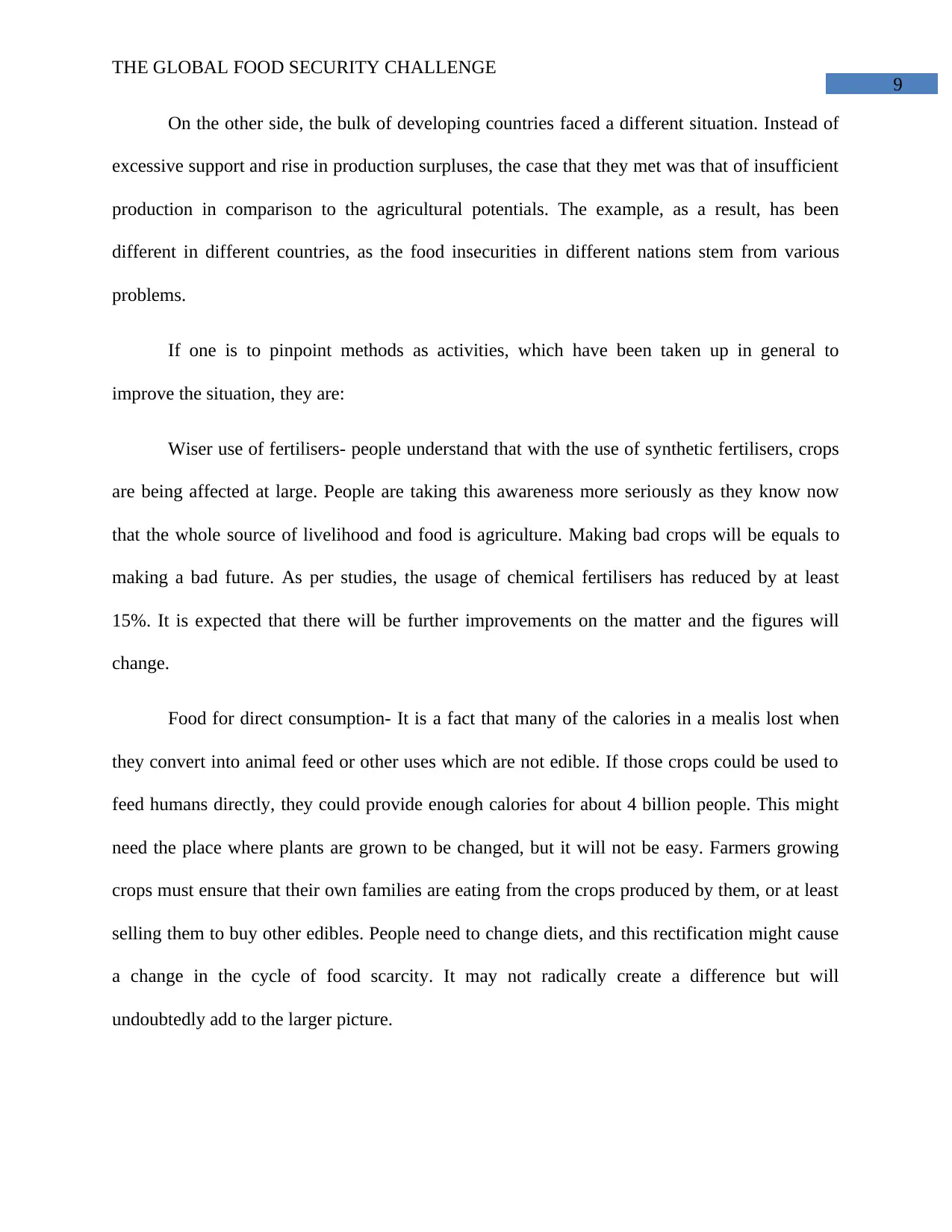
9
THE GLOBAL FOOD SECURITY CHALLENGE
On the other side, the bulk of developing countries faced a different situation. Instead of
excessive support and rise in production surpluses, the case that they met was that of insufficient
production in comparison to the agricultural potentials. The example, as a result, has been
different in different countries, as the food insecurities in different nations stem from various
problems.
If one is to pinpoint methods as activities, which have been taken up in general to
improve the situation, they are:
Wiser use of fertilisers- people understand that with the use of synthetic fertilisers, crops
are being affected at large. People are taking this awareness more seriously as they know now
that the whole source of livelihood and food is agriculture. Making bad crops will be equals to
making a bad future. As per studies, the usage of chemical fertilisers has reduced by at least
15%. It is expected that there will be further improvements on the matter and the figures will
change.
Food for direct consumption- It is a fact that many of the calories in a mealis lost when
they convert into animal feed or other uses which are not edible. If those crops could be used to
feed humans directly, they could provide enough calories for about 4 billion people. This might
need the place where plants are grown to be changed, but it will not be easy. Farmers growing
crops must ensure that their own families are eating from the crops produced by them, or at least
selling them to buy other edibles. People need to change diets, and this rectification might cause
a change in the cycle of food scarcity. It may not radically create a difference but will
undoubtedly add to the larger picture.
THE GLOBAL FOOD SECURITY CHALLENGE
On the other side, the bulk of developing countries faced a different situation. Instead of
excessive support and rise in production surpluses, the case that they met was that of insufficient
production in comparison to the agricultural potentials. The example, as a result, has been
different in different countries, as the food insecurities in different nations stem from various
problems.
If one is to pinpoint methods as activities, which have been taken up in general to
improve the situation, they are:
Wiser use of fertilisers- people understand that with the use of synthetic fertilisers, crops
are being affected at large. People are taking this awareness more seriously as they know now
that the whole source of livelihood and food is agriculture. Making bad crops will be equals to
making a bad future. As per studies, the usage of chemical fertilisers has reduced by at least
15%. It is expected that there will be further improvements on the matter and the figures will
change.
Food for direct consumption- It is a fact that many of the calories in a mealis lost when
they convert into animal feed or other uses which are not edible. If those crops could be used to
feed humans directly, they could provide enough calories for about 4 billion people. This might
need the place where plants are grown to be changed, but it will not be easy. Farmers growing
crops must ensure that their own families are eating from the crops produced by them, or at least
selling them to buy other edibles. People need to change diets, and this rectification might cause
a change in the cycle of food scarcity. It may not radically create a difference but will
undoubtedly add to the larger picture.
Paraphrase This Document
Need a fresh take? Get an instant paraphrase of this document with our AI Paraphraser
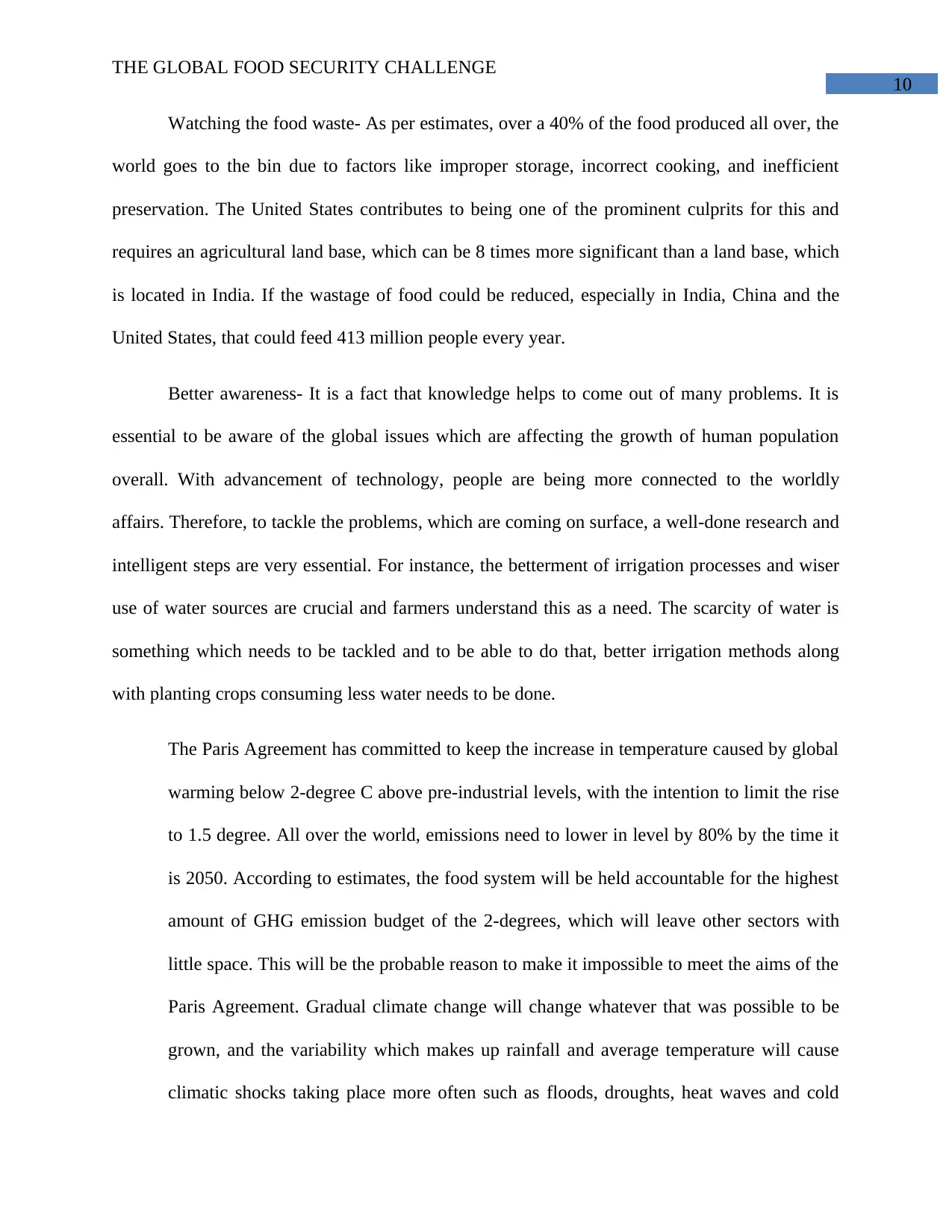
10
THE GLOBAL FOOD SECURITY CHALLENGE
Watching the food waste- As per estimates, over a 40% of the food produced all over, the
world goes to the bin due to factors like improper storage, incorrect cooking, and inefficient
preservation. The United States contributes to being one of the prominent culprits for this and
requires an agricultural land base, which can be 8 times more significant than a land base, which
is located in India. If the wastage of food could be reduced, especially in India, China and the
United States, that could feed 413 million people every year.
Better awareness- It is a fact that knowledge helps to come out of many problems. It is
essential to be aware of the global issues which are affecting the growth of human population
overall. With advancement of technology, people are being more connected to the worldly
affairs. Therefore, to tackle the problems, which are coming on surface, a well-done research and
intelligent steps are very essential. For instance, the betterment of irrigation processes and wiser
use of water sources are crucial and farmers understand this as a need. The scarcity of water is
something which needs to be tackled and to be able to do that, better irrigation methods along
with planting crops consuming less water needs to be done.
The Paris Agreement has committed to keep the increase in temperature caused by global
warming below 2-degree C above pre-industrial levels, with the intention to limit the rise
to 1.5 degree. All over the world, emissions need to lower in level by 80% by the time it
is 2050. According to estimates, the food system will be held accountable for the highest
amount of GHG emission budget of the 2-degrees, which will leave other sectors with
little space. This will be the probable reason to make it impossible to meet the aims of the
Paris Agreement. Gradual climate change will change whatever that was possible to be
grown, and the variability which makes up rainfall and average temperature will cause
climatic shocks taking place more often such as floods, droughts, heat waves and cold
THE GLOBAL FOOD SECURITY CHALLENGE
Watching the food waste- As per estimates, over a 40% of the food produced all over, the
world goes to the bin due to factors like improper storage, incorrect cooking, and inefficient
preservation. The United States contributes to being one of the prominent culprits for this and
requires an agricultural land base, which can be 8 times more significant than a land base, which
is located in India. If the wastage of food could be reduced, especially in India, China and the
United States, that could feed 413 million people every year.
Better awareness- It is a fact that knowledge helps to come out of many problems. It is
essential to be aware of the global issues which are affecting the growth of human population
overall. With advancement of technology, people are being more connected to the worldly
affairs. Therefore, to tackle the problems, which are coming on surface, a well-done research and
intelligent steps are very essential. For instance, the betterment of irrigation processes and wiser
use of water sources are crucial and farmers understand this as a need. The scarcity of water is
something which needs to be tackled and to be able to do that, better irrigation methods along
with planting crops consuming less water needs to be done.
The Paris Agreement has committed to keep the increase in temperature caused by global
warming below 2-degree C above pre-industrial levels, with the intention to limit the rise
to 1.5 degree. All over the world, emissions need to lower in level by 80% by the time it
is 2050. According to estimates, the food system will be held accountable for the highest
amount of GHG emission budget of the 2-degrees, which will leave other sectors with
little space. This will be the probable reason to make it impossible to meet the aims of the
Paris Agreement. Gradual climate change will change whatever that was possible to be
grown, and the variability which makes up rainfall and average temperature will cause
climatic shocks taking place more often such as floods, droughts, heat waves and cold
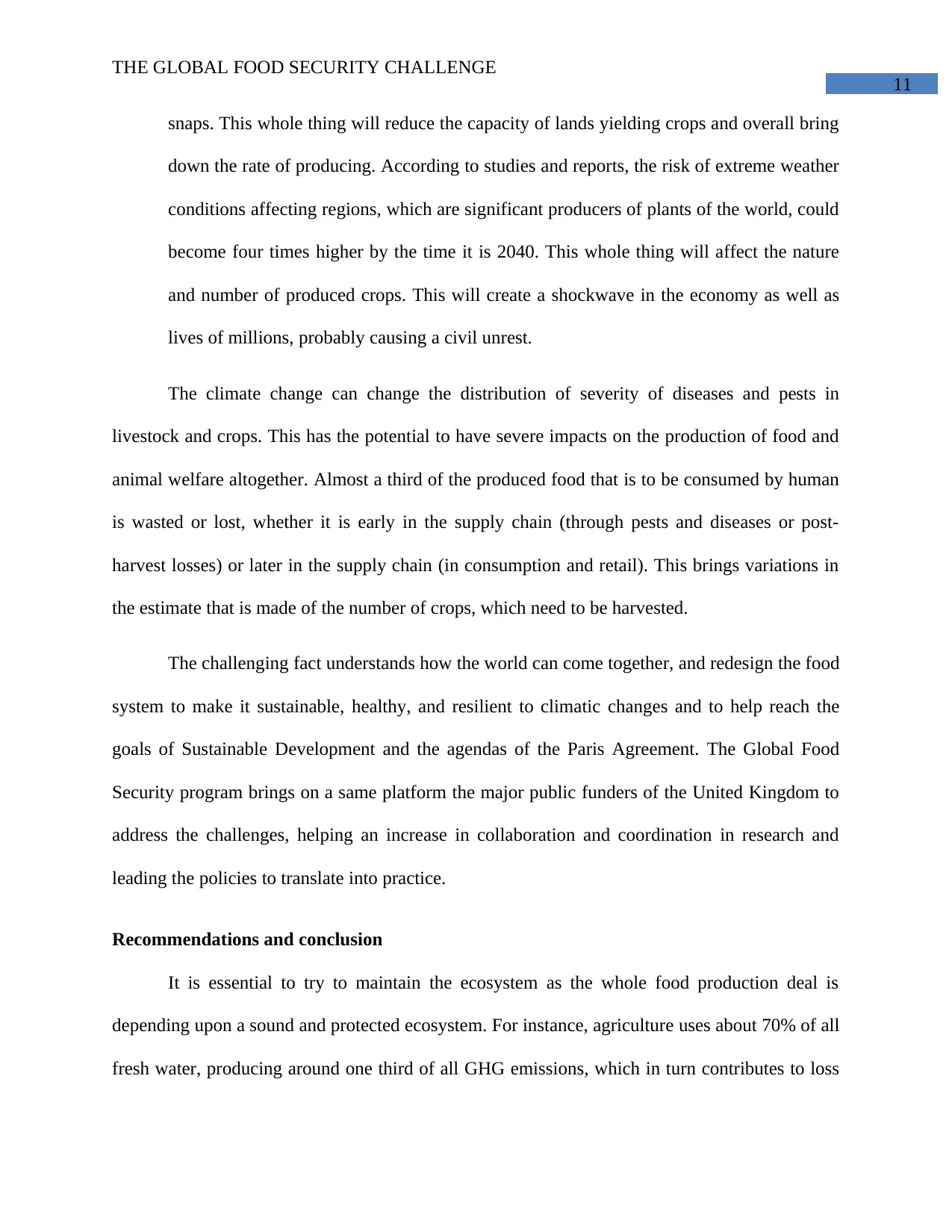
11
THE GLOBAL FOOD SECURITY CHALLENGE
snaps. This whole thing will reduce the capacity of lands yielding crops and overall bring
down the rate of producing. According to studies and reports, the risk of extreme weather
conditions affecting regions, which are significant producers of plants of the world, could
become four times higher by the time it is 2040. This whole thing will affect the nature
and number of produced crops. This will create a shockwave in the economy as well as
lives of millions, probably causing a civil unrest.
The climate change can change the distribution of severity of diseases and pests in
livestock and crops. This has the potential to have severe impacts on the production of food and
animal welfare altogether. Almost a third of the produced food that is to be consumed by human
is wasted or lost, whether it is early in the supply chain (through pests and diseases or post-
harvest losses) or later in the supply chain (in consumption and retail). This brings variations in
the estimate that is made of the number of crops, which need to be harvested.
The challenging fact understands how the world can come together, and redesign the food
system to make it sustainable, healthy, and resilient to climatic changes and to help reach the
goals of Sustainable Development and the agendas of the Paris Agreement. The Global Food
Security program brings on a same platform the major public funders of the United Kingdom to
address the challenges, helping an increase in collaboration and coordination in research and
leading the policies to translate into practice.
Recommendations and conclusion
It is essential to try to maintain the ecosystem as the whole food production deal is
depending upon a sound and protected ecosystem. For instance, agriculture uses about 70% of all
fresh water, producing around one third of all GHG emissions, which in turn contributes to loss
THE GLOBAL FOOD SECURITY CHALLENGE
snaps. This whole thing will reduce the capacity of lands yielding crops and overall bring
down the rate of producing. According to studies and reports, the risk of extreme weather
conditions affecting regions, which are significant producers of plants of the world, could
become four times higher by the time it is 2040. This whole thing will affect the nature
and number of produced crops. This will create a shockwave in the economy as well as
lives of millions, probably causing a civil unrest.
The climate change can change the distribution of severity of diseases and pests in
livestock and crops. This has the potential to have severe impacts on the production of food and
animal welfare altogether. Almost a third of the produced food that is to be consumed by human
is wasted or lost, whether it is early in the supply chain (through pests and diseases or post-
harvest losses) or later in the supply chain (in consumption and retail). This brings variations in
the estimate that is made of the number of crops, which need to be harvested.
The challenging fact understands how the world can come together, and redesign the food
system to make it sustainable, healthy, and resilient to climatic changes and to help reach the
goals of Sustainable Development and the agendas of the Paris Agreement. The Global Food
Security program brings on a same platform the major public funders of the United Kingdom to
address the challenges, helping an increase in collaboration and coordination in research and
leading the policies to translate into practice.
Recommendations and conclusion
It is essential to try to maintain the ecosystem as the whole food production deal is
depending upon a sound and protected ecosystem. For instance, agriculture uses about 70% of all
fresh water, producing around one third of all GHG emissions, which in turn contributes to loss
⊘ This is a preview!⊘
Do you want full access?
Subscribe today to unlock all pages.

Trusted by 1+ million students worldwide
1 out of 22
Related Documents
Your All-in-One AI-Powered Toolkit for Academic Success.
+13062052269
info@desklib.com
Available 24*7 on WhatsApp / Email
![[object Object]](/_next/static/media/star-bottom.7253800d.svg)
Unlock your academic potential
Copyright © 2020–2025 A2Z Services. All Rights Reserved. Developed and managed by ZUCOL.





